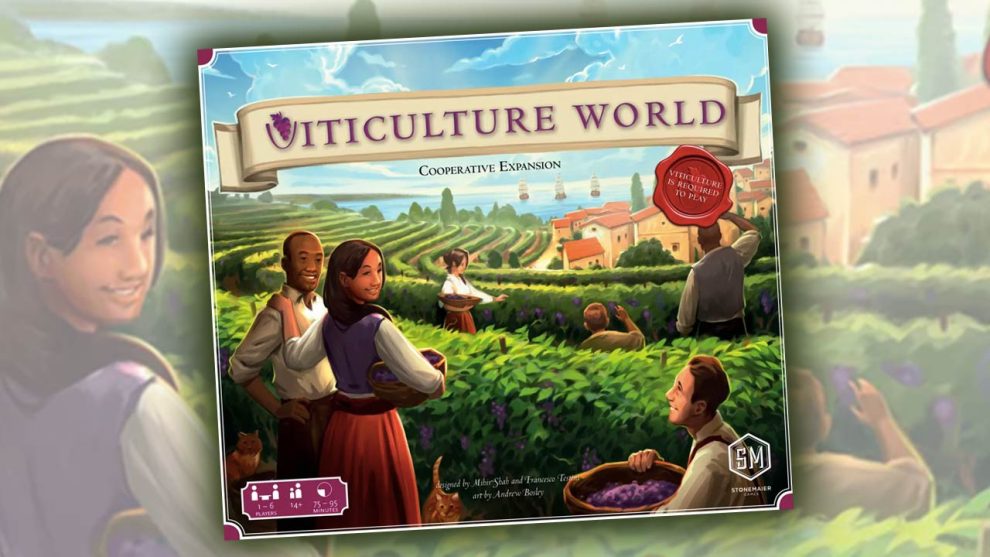I like a good challenge, but with the new cooperative expansion to Viticulture, Viticulture World (2022, Stonemaier Games), I was struggling to make it through the first world of the game.
I reached out to a friend who had purchased the game at retail, “Am I crazy, or is Viticulture World surprisingly hard to beat even in the tutorial mission?”
“Dude. So ******** hard,” was the text reply.
Viticulture World is that kind of game. I was getting beaten so badly in my solo plays that I rewatched the official rules video just to make sure I was playing the game correctly. Sadly, I was playing the game correctly, so that led to a different conversation:
Is Viticulture World too difficult?

Bring a Machete (Plus One For a Friend)
In Viticulture World, you are mostly playing the base game of Viticulture (with or without its expansions) with up to five friends, but on the same team.
By “team”, I mean that you are working with other players to each create a prosperous wine business. Everyone is super friendly, and with millions of bottles of wine sold each year, there’s plenty of money to go around. Why not spread the love?
Players take turns like they would in Viticulture, on a board very similar to the one used in Viticulture save for a few minor changes. Actions can be upgraded in Viticulture World with innovation tiles. There’s an influence track, which needs to advance to the final space on its track as one of your victory conditions (the other condition: each player has to score 25 points). New actions allow for cash to be exchanged for buying worker placement space upgrades, or to buy your way up the influence track.
The “Wake Up” bonuses are still here, but placed on a radial instead of a turn order track, since you aren’t necessarily gunning to go before anyone else. Fall bonuses include not only a choice of visitor cards, but you could take two units of money instead (more on that in a moment) or age one of your grapes up one level in value on your crush pad.

But the rest of Viticulture World aligns with an event deck which changes how the game plays. There are seven decks included in the game, scaled for player difficulty, from Greengully (the tutorial) to South America (medium) to Africa (ridiculous!).
These event decks feature cards which can be mixed and matched from a nine-card pool in each deck. Based on your setting lots of fun things can happen: changes to the base rules, ongoing player powers, raising or lowering the price of certain actions for a single round. Also, the base game’s monetary unit was lira, but in Viticulture World, just assume the currency changes from deck to deck.
What doesn’t change is the number of rounds: in Viticulture World, you only get six rounds to score 25 points. And this is my main issue with this expansion: I have struggled to score even 20 points in the base game in six rounds, so to score 25% more points feels epic.
Oh, and did I mention that EVERY player has to get to 25 points?

Hard Target
Viticulture World is hard. My first reaction to this was one of self-reflection: I am apparently not a great Viticulture player.
Viticulture World is best for strong Viticulture players, and maybe only those players. If you spent most of your time losing on easy to the base game’s solo variant, or losing often to the game’s easy AI in the iOS app, skip Viticulture World post haste.
Nothing about the cooperative version is going to fix the ability to solve the gameplay loop of the base game. You are still making wine. You are still subject to a card draw, which is entirely random. You still have to master an already-tight efficiency loop with only five workers (this is locked in Viticulture World; never more, never less) where it feels like you have to do lots of things right out of the gates to set yourself up for success.
In Viticulture World, you can make trades with another player when you place your “grande” worker on the same space as that other player. And those trades could be vital, be it for money, cards that you can play where another player could not, or trading your grapes or wine to fulfill wine orders.
I have a feeling Viticulture veterans are loving the challenge that this co-op expansion provides. I’m sure quarterbacking—the act of having one experienced player dominate the thinking of how other players at the table take actions—will be a problem here, but that’s the world of co-op gaming.
I’ve played the game six times, and I’ve only won twice, both on the revamped Greengully tutorial setup. Usually, I’ve gotten demolished (I’m still having flashbacks about the thumping that took place in South America), but I’ll give Viticulture World this much: it’s fun to play, even as you realize that by round five you’ve only got 11 points and there’s no way each of you can score 25 victory points. Working with other players, reacting to how each player can take actions that help the group, determining which items to trade and how to get your grande worker on a spot late in a round to make a fun play…all that works well here.
And, maybe the biggest credit to the designers of Viticulture World: this game has made me go back to play the base game a few times to remember why I liked Viticulture. It was fun to dive back in for a few plays to warm up for Viticulture World.

Serious Players Only
Viticulture World is for Viticulture enthusiasts, period.
Even those who prefer competitive games will find things to like about how Viticulture World embraces co-op play but in a format where you are still doing lots of, well, Viticulture things: planting vines, harvesting fields, building structures, filling orders.
All my plays featured three players or fewer, and that was plenty for me. As with the base game, I think playing this at six players would be a living nightmare. There’s plenty to offer at the lower player count and the game feels like it scales well between solo, two, and three-player counts.
The Stonemaier touch is such a fantastic guarantee when it comes to production—everything about the Viticulture World production is lux. Handsome board, great cards, solid components. The only miss for me are the hats workers wear to signify their initial ability to only work during the summer or winter season. The hats don’t stay on very well, and I played this with two different sets (my review copy, plus the copy of another friend), so the hat issue feels pretty consistent.
For gamers who hate co-op games that are too easy, don’t worry: Viticulture World has you covered, particularly with seven different difficulties included in the box. That means you’ll be playing Viticulture World for a while, especially if you are like me and you play it a bunch just to see if you can score a win. It was a grind, but when you finally do win, it feels good!












Add Comment